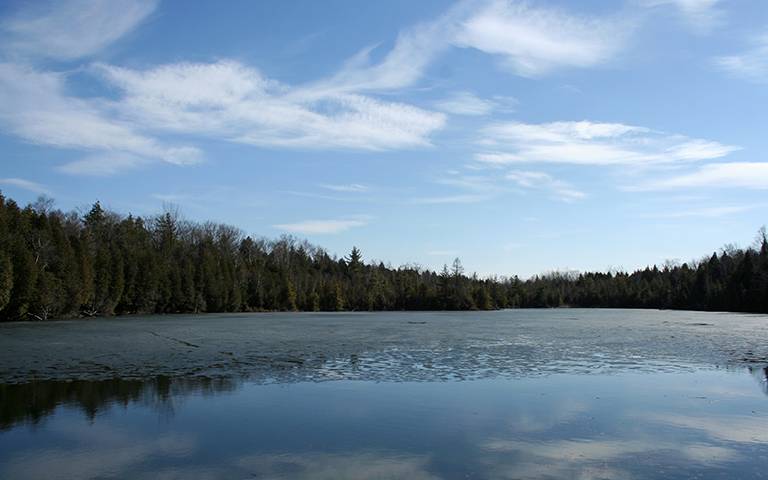Anthropocene Working Group proposes Crawford Lake as GSSP candidate site of the Anthropocene
17 July 2023
The proposal signals a significant milestone in validating the geological impact of human activities on Earth, marking a crucial step towards recognising the Anthropocene epoch.

This article was first published on UCL News
In a joint press conference last week with the Max Planck Society (MPG), the Anthropocene Working Group (AWG) announced Crawford Lake, Canada as the proposed Global boundary Stratotype Section and Point (GSSP) candidate site of the Anthropocene series. Selecting Crawford Lake marks a significant step in the AWG’s effort to test the geological validity of the Anthropocene hypothesis and towards the scientific, and thereby also political and social recognition of the scale and severity of planetary transformation processes unleashed by industrialized humanity.
UCL Context
Members of UCL Geography have been pivotal in this process. From 2019 Dr Simon Turner has acted as scientific coordinator for this international collaborative project of the AWG, HKW and the Max Planck Institute for the History for Science, exploring the cultural and scientific dimensions of this proposed new epoch. He is also Secretary of the Anthropocene Working Group.
With support from the Haus der Kulturen der Welt (HKW), the team from UCL Geography (Emeritus Professor Neil Rose, Dr Sarah Roberts [now at CEH Wallingford], Dr Lucy Roberts and Dr Handong Yang) processed samples from the sites for key measurements of natural and artificial radionuclides (UCL Radiometric Facility) and spheroidal carbonaceous particles (SCPs) which are evidence of high temperature of fossil fuel combustion and a key marker of the proposed Anthropocene. One aspect of this work on SCPs has been the first discovery of these particles in an Antarctic ice core.
Background
A prerequisite for the recognition of a new unit of the chronostratigraphic time scale is the identification and description of a geological profile indicating the onset of planetary-scale change, a Global boundary Stratotype Section and Point (GSSP). Since 2019, the AWG has coordinated a systematic study at twelve different sites across the globe, representing different environmental archives, for geological evidence of the proposed Anthropocene series in strata and its equivalent in time the Anthropocene epoch. After months of deliberations and a series of votes, the AWG now proposes a sediment core from the bottom of Crawford Lake (Ontario, Canada) as host of the GSSP candidate site of the Anthropocene series. The research findings of Crawford Lake provide strong evidence for the AWG’s hypothesis that the unprecedented increase in industrial and socioeconomic activity of the Great Acceleration around the mid-twentieth century has caused alterations to the Earth System on a scale that terminated ~11,700 years of largely stable Holocene conditions and marks the beginning of a new Earth epoch.
Next Steps
The full proposal of the AWG needs to be agreed and voted on by the AWG before it is presented to the Subcommission on Quaternary Stratigraphy (SQS) later this summer 2023. Members of the SQS will need to vote on the proposal and if they agree with a 60% majority it will then pass on to the International Commission on Stratigraphy (ICS) who will also have to vote and agree with a 60% majority for the proposal to move onwards to the International Union of Geological sciences (IUGS) for consideration of final ratification. There is no guarantee following AWG submission to the SQS the proposal will indeed succeed. However, the results of the AWG’s multi-year study mark both a substantial step forward in the formalization process of the Anthropocene epoch and constitute a major scientific achievement in recognizing the fundamental impact that human activities have inflicted on the planet.
- For more information about this story, please contact Dr Simon Turner
 Close
Close

